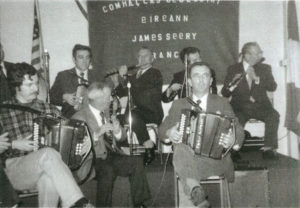The Burke-Curry-Seery branch officers for 2017-2018 are:
Chairperson: Sean Carroll
Vice Chairperson: Bob Stearns
Secretary: Heather Carroll
Treasurer: Sean Carroll
Youth Officer: Open
Public Relations: Ginny Worrell
Auditor: Dave Porteus
Delegates to the Regional Board (2) – open
Gaelic Language Leader – open
The Burke-Curry-Seery Branch of Comhaltas
Here’s a photo (click the photo for enlargement) of Mike Rafferty at the inauguration of the Jim Seery Branch held at the John Boyle O’Reilly Club in Springfield Ma early 1970’s. Included in the photo with Mike are back row (left to right) – Sean McGlynn, Mike Rafferty, Mike Preston, Tom O’Brien front row John Tabb, Jack Coen and Brendan McCann.
Go to Eddie’s web site to learn more about Eddie Burke, one of our branches namesake.
History of Comhaltas
COMHALTAS is an international organization that promotes the culture, language, music, and dance of Ireland. It began in January of 1951 when representatives of the Pipers Club, Dublin, traveled to Mullingar with a view of forming a branch of the Pipers Club in Mullingar. It was at this meeting that a decision to include all traditional instrumentalists was made. The following month, February 4, 1951, a meeting was convened to arrange for the holding of the first Fleadh, or festival, in conjunction with feis lar na hEireann the following May on the Whit Sunday weekend.
The aims of the Fleadh were to restore to it’s rightful place, the traditional music of Ireland and to reverse the decadent trend apparent in Irish life at that time. It was proposed to bring to Mullingar the best of traditional musicians from every part of Ireland.
On Sunday, May 19, 1951, the first Fleadh was held in St. Mary’s Hall, Mullingar. The proceedings began with a convention followed by a concert and ceili. The following day, traditional musicians from all parts of Ireland took part in the traditional music competition organized by the local feis committees.
It was here that the first Fleadh Cheoil na hEireann of Comhaltas Ceoltoiri Eireann took place even though the title of Comhaltas did not emerge for some months afterwards.
It was during this interim that the founding members would agree that the idea for a great National Fleadh — festival of Irish Music — would be organized on a national scale by the musicians themselves.
The need for such a festival and such an organization had been sorely needed for some time. Although there were thousands of traditional musicians in the country, they kept a low profile; their music was entirely unappreciated in the social, intellectual, and “trendy” circles. The ordinary people of the countryside loved the music — it being their own music — but the tendency in supposedly sophisticated circles was to deride and scoff at the traditional music of Ireland as being of no real beauty or value.
Traditional musicians who entered competitions for “Irish Music” were frequently advised to change their approach, discard their traditional intonation and techniques, and “learn to play properly.”
The first Fleadhanna Cheoil then gave traditional musicians a platform where they could play to a really appreciative audience and where traditional style was the criterion. The first Fleadh attracted only a few die-hard patrons but within five years, the annual gathering had grown to a great National Festival attended by thousands of traditional musicians, singers, and dancers from all parts of Ireland and overseas.
In 1956, Ennis saw a turnout that was truly national, as sessions overflowed from the halls and pubs to block the narrow streets while set dancers from Kilmaley and Quilty “battered” the night away. Fleadh Cheoil na hEireann had come to stay. Right through the sixties and seventies the Fleadh continued to grow and the number of competitors grew so large that qualifying stages had to be arranged at county and provincial level so that a reasonably manageable number (some 2500 or more) could take part in the All-Ireland finals a Fleadh Cheoil na hEireann.
Branches of CCE sprung up all over Ireland and over the past forty years the Fleadh and Comhaltas grew hand-in-hand. There are now over 400 branches promoting the music, song, dance, and language of Ireland and Comhaltas events are attended annually by over a million people. Comhaltas has been a powerful force for good in bringing people of different politics and creeds together. Today, Comhaltas is rooted in every one of the thirty-two counties of Ireland. It is also extensively organized through the Irish communities in Britain, the United States, Canada, France, Sweden, Luxembourg, Australia, Japan, and Italy. Many non-Irish friends of Ireland have joined this extraordinary movement.

